Ingesting poisonous plants in Wisconsin can be hazardous and result in major health problems. These toxic plants can cause everything from slight skin irritation to organ failure, and in extreme circumstances, even death. However, this depends on the specific species of plant.
We’re breaking down the most dangerous plant species that can be found in the Badger State in this guide. The more you know about poisonous plants, the better you can arm yourself with knowledge and avoid coming into contact with them!
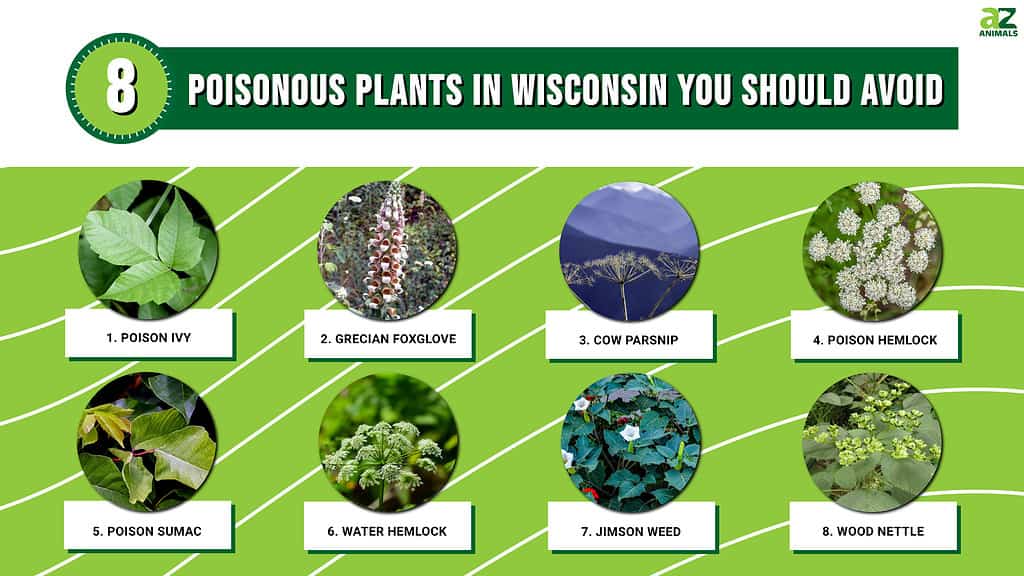
1. Poison Ivy
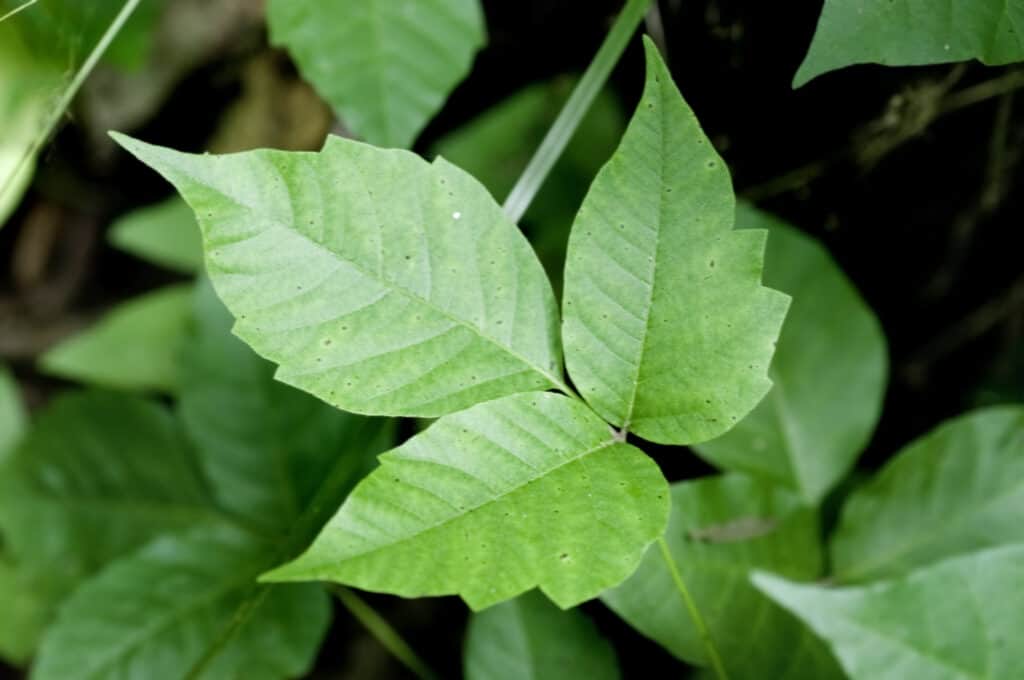
Poison ivy (pictured) has compound leaves consisting of three individual leaflets.
©Tim Mainiero/Shutterstock.com
Classification: Toxicodendron radicans
You can’t have a list of poisonous plants in Wisconsin without mentioning poison ivy! The infamous plant known as poison ivy is notorious for giving humans adverse skin reactions. It is a plant that may be found in Wisconsin and is a part of the cashew Anacardiaceae.
Poison ivy’s appearance can change based on its development stage and the surrounding environment. It normally develops into a woody vine or shrub with three-leafed compound leaves. The glossy, toothed, or smooth-edged leaflets have pointy ends. The leaves are green in the spring and summer but turn vivid hues of red, orange, or yellow in the fall. Additionally, the plant produces tiny clusters of greenish-white blooms, which are followed by off-white or white berries that stick around into the winter.
Forests, farms, roadside ditches, and even cities support the growth of poison ivy. In Wisconsin, it is frequently found in forested regions, alongside trails, and along the borders of woods. It can spread as a ground cover, trail along the ground, or use aerial roots to climb trees or other structures.
Understanding Urushiol
An oily substance known as urushiol can be found in the plant’s leaves, stems, and roots. It is what makes poison ivy poisonous. A skin rash marked by redness, itching, swelling, and the development of fluid-filled blisters can result after direct contact with urushiol. Usually starting a few hours to a few days after exposure, these symptoms might linger for several weeks. Internal irritability and gastrointestinal upset can also result from ingesting any portion of the plant.
It’s crucial to remember that poison ivy may be harmful to animals as well. Many mammals, including pets and cattle, can have allergy responses resembling those seen in humans. That being said, certain animals such as birds are resistant to the effects of urushiol.
2. Grecian Foxglove
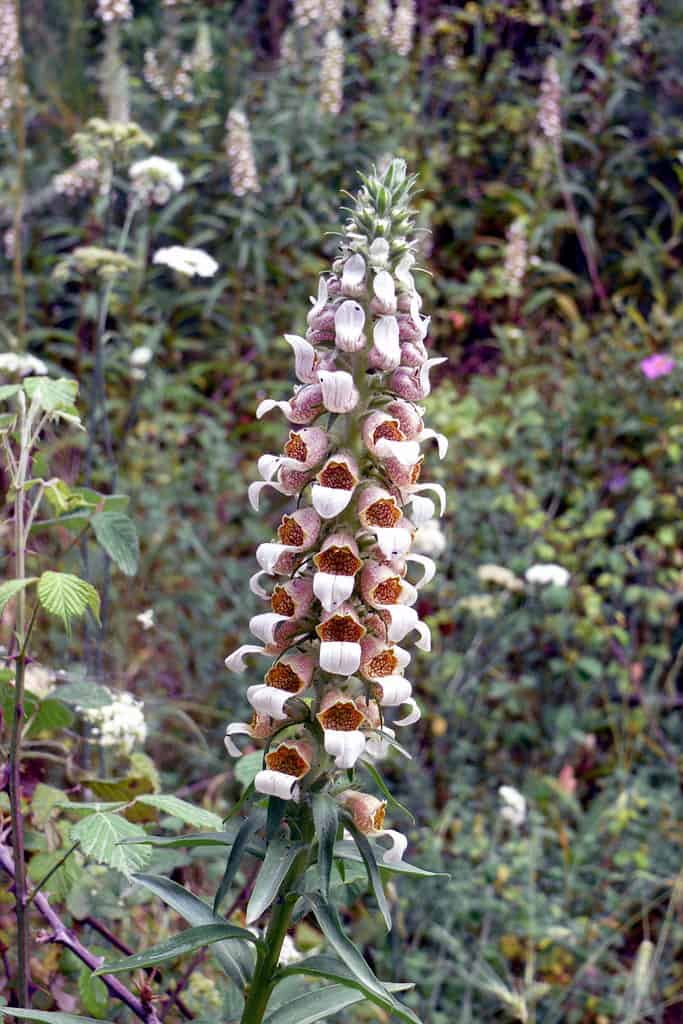
Grecian foxglove, like other foxglove species, contains cardiac glycosides such as digoxin which can significantly affect the heart.
©User:Haplochromis, CC BY-SA 3.0 – License
Classification: Digitalis lanata
This species of blooming plant in the foxglove genus Digitalis is known as the Grecian foxglove. Grecian foxglove is a perennial herbaceous plant that normally reaches a height of three feet. The plant gets its popular name from its long, lance-shaped leaves coated with tiny, woolly hairs. The plant’s basal rosette of leaves is composed of grayish-green leaves.
This plant produces long flower spikes covered with bell-shaped blooms in the late spring and early summer. The interior of the blooms often has purple-brown patterns and is creamy or yellowish-white in color. They draw pollinators like hummingbirds and bees. Grecian foxglove produces seed capsules that are filled with countless tiny seeds after the blooms have faded.
Grecian foxglove is not a native or often encountered wild plant in Wisconsin. It is typically produced in gardens or under regulated conditions for therapeutic uses. If found in the state, it would probably be in someone’s backyard or a museum’s collection of plants. Because it is a popular garden plant in the Midwest, though, it is worth mentioning on this list.
Grecian foxglove, like other foxglove species, contains cardiac glycosides such as digoxin which can significantly affect the heart. If consumed, these poisonous substances can be very harmful. It’s critical to use caution and restrict children and animals from accessing this plant.
3. Cow Parsnip

Furocoumarins, which are present in the sap of cow parsnip, might make certain people photosensitive and irritate their skin.
©ESB Essentials/Shutterstock.com
Classification: Heracleum maximum
The herbaceous perennial plant known as cow parsnip is indigenous to North America, and it is one of the most common poisonous plants in Wisconsin. It belongs to the family Apiaceae and is renowned for its spectacular beauty and tall growth. Unfortunately, it’s also known for being quite irritating to the skin.
Usually reaching a height of three to eight feet, cow parsnip has thick, hollow stems with broad, widely lobed, and toothed leaves. The leaves have a rough texture and are a pale green color. Large, umbrella-shaped flower clusters made up of countless little white blooms are produced by the shrub. The diameter of these clusters can be as big as one foot. From late spring through early summer, cow parsnip blossoms.
Cow parsnip grows in a variety of environments in Wisconsin, including meadows, grasslands, open forests, and riverbanks. It thrives in environments with fertile, damp soil.
Furocoumarins, which are present in the sap of cow parsnip, might make certain people photosensitive and irritate their skin. The disease known as phytophotodermatitis can develop if the sap comes into contact with the skin and is subsequently exposed to sunshine. Symptoms of this include redness, blisters, and increased sensitivity to sunlight.
It’s important to note that cow parsnip might be mistaken for giant hogweed (a.k.a. Heracleum mantegazzianum), a closely related plant that is regarded as being more dangerous. Giant hogweed sap can result in serious skin burns.
4. Poison Hemlock
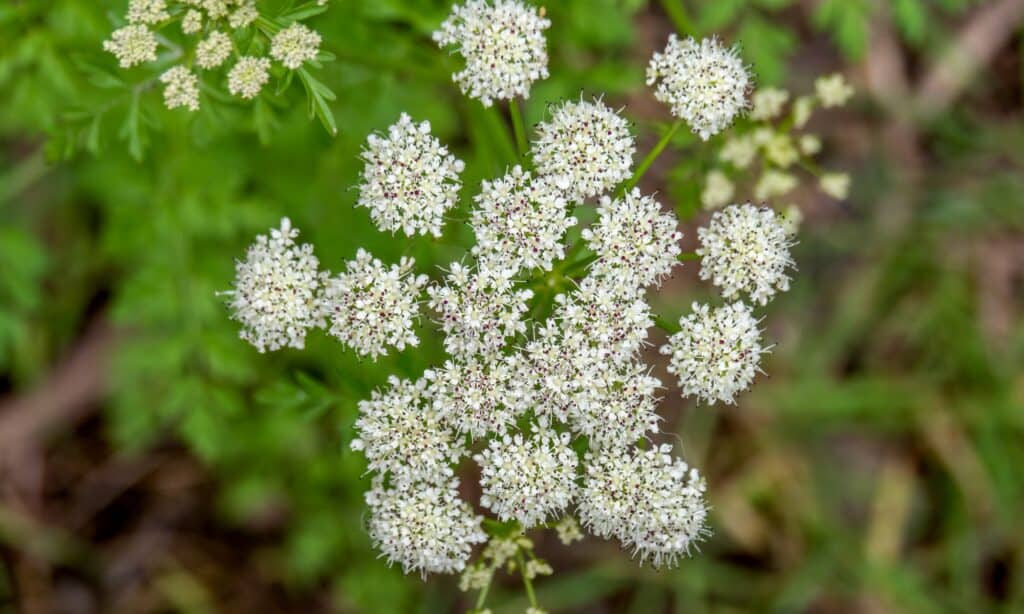
Poison hemlock (pictured) looks very similar to wild carrot.
©iStock.com/Goldfinch4ever
Classification: Conium maculatum
Native to Europe, poison hemlock is an extremely poisonous plant that has spread throughout North America, including Wisconsin. It is an extremely dangerous plant that is not only one of the most poisonous plants in Wisconsin but one of the most poisonous plants in North America. It is a member of the family Apiaceae and is distinguished by both its unusual look and strong toxicity.
A biennial or perennial plant, poison hemlock grows three to 10 feet tall. It has stems that are smooth and hollow and frequently have purple patches or streaks on them. The leaves are deeply split, pinnately arranged, and fern-like in appearance. Umbels, or flower clusters in the form of an umbrella, appear on this plant from spring through summer.
In Wisconsin, poison hemlock can be found in a variety of environments, including along riverbanks, waste areas, meadows, and on the roadside. It may grow in both sunny and partially shaded areas. It tends to favor wet, rich soils.
Coniine and other alkaloids are among the poisonous ingredients found in poison hemlock. These chemicals have negative effects on the central nervous system and are exceedingly harmful to consume. The plant is deadly to both people and animals in all of its components, including the leaves, stems, flowers, and seeds. Ingestion can cause life-threatening symptoms such as convulsions, respiratory failure, and paralysis.
It is essential to use caution and stay away from poison hemlock due to its toxicity. Seek emergency medical treatment or get in touch with a poison control center if you suspect ingestion or experience poisoning symptoms.
5. Poison Sumac
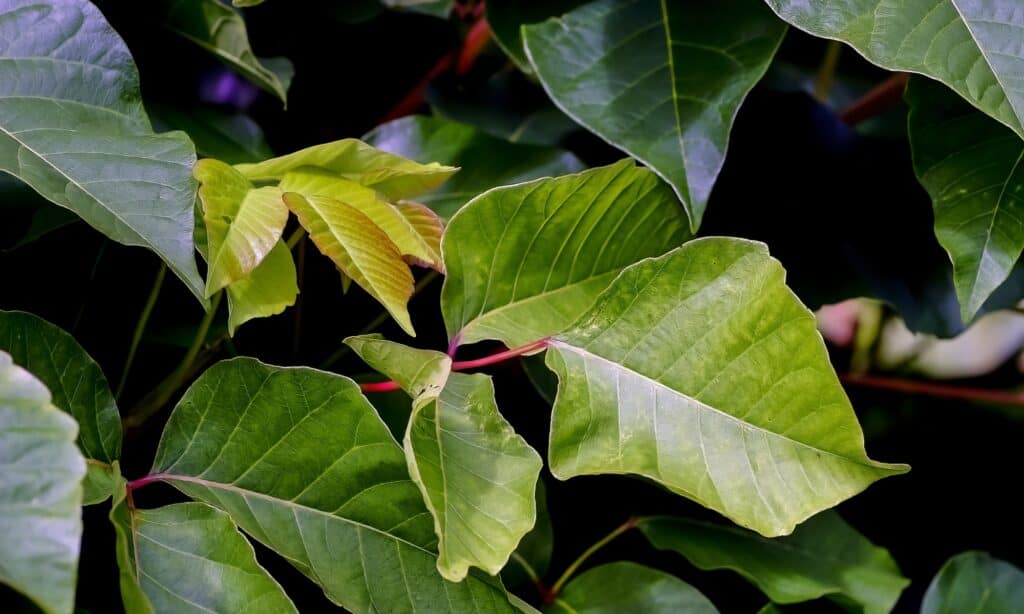
The powerful allergic responses that poison sumac may produce are well recognized, as is its striking look.
©iStock.com/Werner Meidinger
Classification: Toxicodendron vernix
Native to North America, poison sumac can be found in some parts of Wisconsin. It belongs to the same family as poison ivy and poison oak, a.k.a. the Anacardiaceae family. The powerful allergic responses that poison sumac may produce are well recognized, as is its striking look.
A woody shrub or small tree, poison sumac normally reaches a height of five to 20 feet. Its complex leaves have seven to 13 leaflets that are grouped in pairs, with one leaflet at the end. The margins of the elliptical leaflets are smooth. Normally green in the spring and summer, the leaves change to vivid hues of red, orange, or yellow in the fall.
In Wisconsin, wetlands including swamps, marshes, and soggy woodlands are where poison sumac is most likely to grow. Acidic soils and high moisture content are ideal for it to flourish.
Allergic Responses to Poison Sumac
Animals and people who come into contact with poison sumac may experience a severe allergic response. The plant contains urushiol, a resin that can irritate the skin and lead to blistering, redness, and itching. Due to the increased quantity of urushiol in poison sumac, the reaction might be even more severe than with poison ivy or poison oak. Respiratory inflammation and pain can also result from inhaling burning poison sumac smoke.
Avoiding direct contact with poison sumac is crucial, as is exercising caution when entering places where it flourishes. If exposure occurs, properly cleaning the area with soap and water can aid in removing the urushiol and reduce the likelihood of a severe response. It is advised to seek medical assistance if symptoms appear or if any plant material is ingested.
6. Water Hemlock
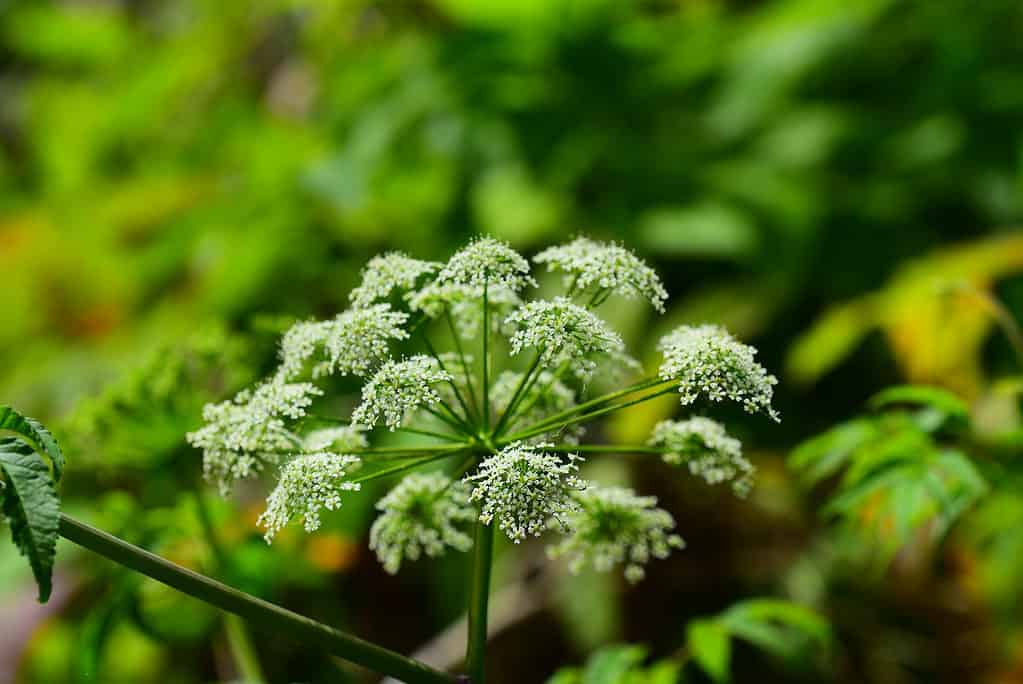
Water hemlock (pictured) is known for favoring very wet or even submerged conditions.
©iStock.com/cturtletrax
Classification: Cicuta maculata
Native to North America, including various parts of Wisconsin, water hemlock is a perennial plant that is extremely deadly. It belongs to the Apiaceae family and is distinguished by its height and high toxicity.
Water hemlock can grow up to eight feet tall. It has stems that are smooth and hollow and usually have reddish or purple striations. The compound leaves have serrated leaflets that give them a lacy look. This plant also has tiny white flowers. From late spring until early summer, these flowers will appear.
In Wisconsin, wetland regions including marshes, swamps, and the sides of rivers or streams are where water hemlock is most frequently seen. It thrives in soil conditions that are damp or even submerged. Water hemlock can even be found along the shore of Lake Michigan in some areas.
Water hemlock is one of the most dangerous plants in North America. It produces cicutoxin, a very toxic substance that affects the central nervous system. It can be fatal to both people and animals if consumed.
The water hemlock plant’s roots, stems, leaves, and seeds all have traces of cicutoxin and are considered dangerous. Severe symptoms include seizures, respiratory failure, convulsions, and even death. It is crucial to use extra caution and stay away from water hemlock. If you notice water hemlock growing on your property, keep children and pets away from it and arrange to have the plant removed.
Water hemlock is a plant that needs to be avoided at all costs due to its severe toxicity. It is critical to get immediate medical help or call a poison control center if you believe you may have consumed water hemlock or come into contact with it.
7. Jimson Weed
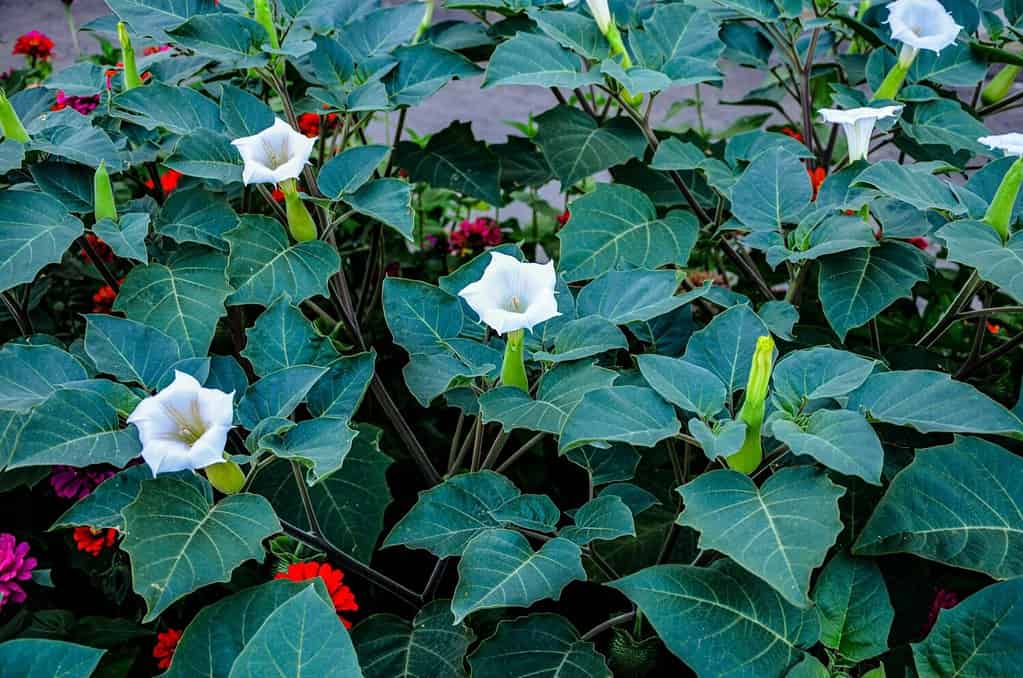
The leaves have jagged edges that are sharply lobed and serrated.
©weha/Shutterstock.com
Classification: Datura stramonium
Jimson weed is a herbaceous annual plant of the Solanaceae family, sometimes known as devil’s snare or thornapple. It is indigenous to North America and is one of the most poisonous plants in Wisconsin. The strong toxicity and stunning look of Jimson weed are well-recognized among horticulturists.
The plant grows bushily and can grow to a height of two to five feet. Large, trumpet-shaped blooms that might be white, purple, or light yellow are featured on its branches. The leaves have jagged edges that are sharply lobed and serrated. The plant has thick, green branches and spiky seed pods that are filled with countless tiny black seeds.
Jimson weed normally grows from late spring to early fall, when the weather is warm. It flourishes in disturbed places like farmed fields, wastelands, and roadside ditches. It may be found all across Wisconsin in sporadic spots.
Jimson weed contains various tropane alkaloids, such as scopolamine, hyoscyamine, and atropine, in both the leaves and seeds. If consumed by either humans or animals, these substances have the potential to have serious effects on the central nervous system.
Jimson weed use can cause a variety of symptoms, such as hallucinations, disorientation, a fast pulse, dry mouth, dilated pupils, impaired vision, and in severe cases, coma or death. Jimson weed is toxic, thus caution should be used and intentional ingestion or contact with it should be avoided. It’s critical to get medical help right away if you accidentally eat this plant or if symptoms start to appear.
8. Wood Nettle
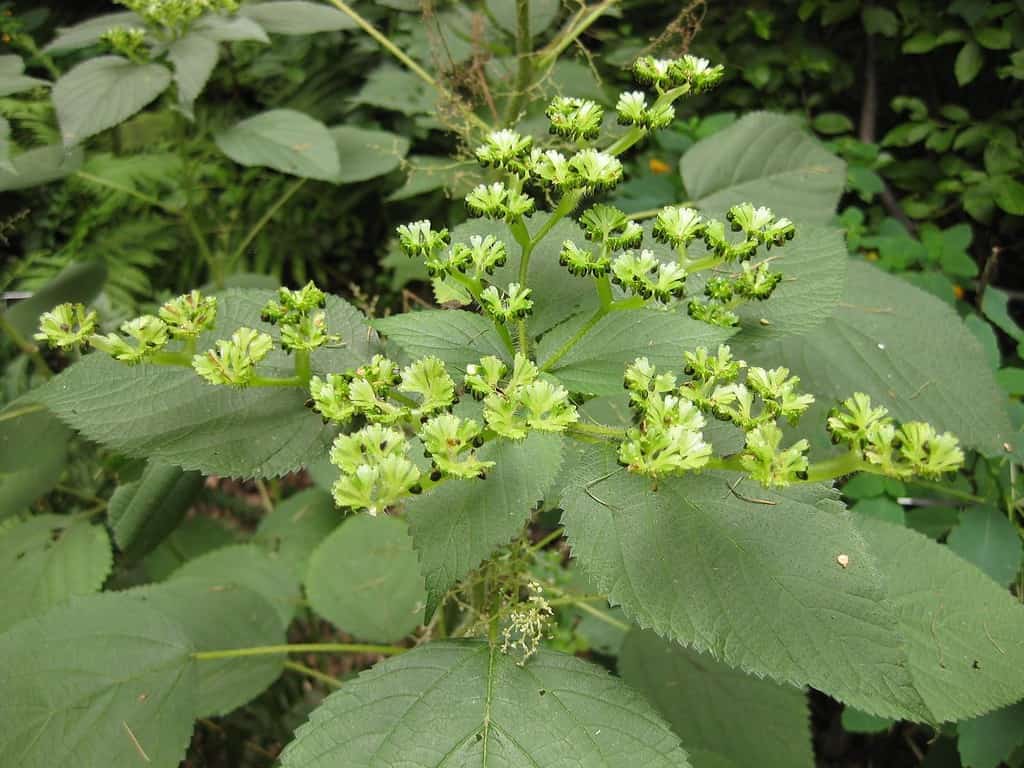
Due to the plant’s stinging hairs, contact with wood nettle can cause a stinging sensation and skin discomfort.
©Raffi Kojian, CC BY-SA 3.0 – License
Classification: Laportea canadensis
Wood nettle is native to North America, including various parts of Wisconsin. It is a perennial plant. It belongs to the family Urticaceae and is well-known for both its unusual look and the stinging feeling it can give when touched.
This plant can reach heights of three to six feet. It has a tall, thin stem with alternate rows of serrated, heart-shaped leaves. The leaves are coated with tiny hairs and have a rough feel. Small, greenish-white flower clusters are produced by the plant, and they bloom from late spring to early summer.
In Wisconsin, this plant can be found in woodlands, forests, and the sides of streams. Wet, shady places are where wood nettle can be found. It favors environments with plenty of moisture and thrives in loamy, rich soils.
The Stinging Hairs of the Wood Nettle
Due to the plant’s stinging hairs, contact with wood nettle can cause a stinging sensation and skin discomfort. Histamines and other compounds found in these hairs have the potential to trigger allergic reactions in certain people. At the location of contact, the response commonly shows up as redness, itching, and a brief rash.
Although wood nettle stings can be unpleasant, the plant is typically not regarded as deadly. The symptoms usually only affect one area and disappear in a few hours to a few days. Individuals with strong allergies or sensitivities, however, might show more pronounced symptoms. It is advised to wash the afflicted region with soap and water after coming into touch with wood nettle and to apply a soothing lotion or anti-itch cream to reduce any discomfort.
Remember to always play it safe when harvesting or searching for plants in the wild. Poisonous plants in Wisconsin are no joke! With this guide as a resource, arm yourself with knowledge the next time you go out foraging for plants.
Summary of 8 Poisonous Plants in Wisconsin You Should Avoid
| Number | Poisonous Plant to Avoid |
|---|---|
| 1 | Poison Ivy |
| 2 | Grecian Foxglove |
| 3 | Cow Parsnip |
| 4 | Poison Hemlock |
| 5 | Poison Sumac |
| 6 | Water Hemlock |
| 7 | Jimson Weed |
| 8 | Wood Nettle |
The photo featured at the top of this post is © Melinda Fawver/Shutterstock.com
Thank you for reading! Have some feedback for us? Contact the AZ Animals editorial team.






